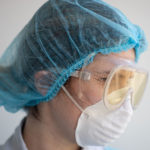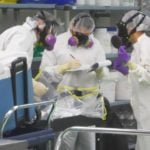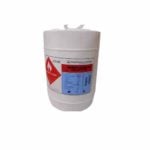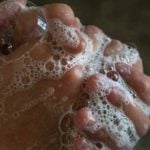Table of Contents
Sterilization & Disinfection Chemicals for Cleanroom Bioburdens
Bacterial and fungal spores are one of the most pervasive and resilient microorganisms on earth. By definition, a sterile environment is 100% free of all microorganisms, including spores. This is essential for bioscience pharmaceutical facilities that require microbiologically clean environments under federally mandated decontamination procedures.
Technologies and chemicals that provide disinfection and sterilization are abundant. The distinction between sterilization and disinfection is an important one. Sterilization methods require the elimination of all microbial life including their spores, while disinfection methods only address vegetative cells. Disinfection methods may slow, disrupt or hinder the proliferation of however disinfection is not considered sporicidal. Therefore, the terms cleaning, sterilization, and disinfection are not synonymous.
What is Sterilization?
Sterilization describes a process that destroys or eliminates all forms of microbial life and is carried out in health-care facilities by physical or chemical methods. Steam under pressure, dry heat, EtO gas, hydrogen peroxide gas plasma, and liquid chemicals are the principal sterilizing agents used in health-care facilities. Sterilization is intended to convey an absolute meaning; unfortunately, however, some health professionals and the technical and commercial literature refer to “disinfection” as “sterilization” and items as “partially sterile.” When chemicals are used to destroy all forms of microbiologic life, they can be called chemical sterilants. These same germicides used for shorter exposure periods also can be part of the disinfection process (i.e., high-level disinfection).
CDC - Introduction, Methods, Definition of Terms
Disinfection describes a process that eliminates many or all pathogenic microorganisms, except bacterial spores, on inanimate objects (Tables 1 and 2). In health-care settings, objects usually are disinfected by liquid chemicals or wet pasteurization. Each of the various factors that affect the efficacy of disinfection can nullify or limit the efficacy of the process.
CDC - Introduction, Methods, Definition of Terms
What is Disinfection?
In this post, we’ll outline the types of chemical disinfectants and sterilants used in cleanrooms and laboratories. This includes isopropyl alcohol, bleach, formaldehyde, hydrogen peroxide, and peracetic acid.
Differences Between Sterilization, Disinfection, & Sporicidal Properties as defined by USP <1072>
Antiseptic—An agent that inhibits or destroys microorganisms on living tissue including skin, oral cavities, and open wounds.
Chemical Disinfectant—A chemical agent used on inanimate surfaces and objects to destroy infectious fungi, viruses, and bacteria, but not necessarily their spores. Sporicidal and antiviral agents are considered a special class of disinfectants.
Cleaning Agent—An agent for the removal from facility and equipment surfaces of product residues that may inactivate sanitizing agents or harbor microorganisms.
Decontamination—The removal of microorganisms by disinfection or sterilization.
Disinfectant—A chemical or physical agent that destroys or removes vegetative forms of harmful microorganisms when applied to a surface. Disinfectants are often categorized as high-level, intermediate-level, and low-level by medically oriented groups based on their efficacy against various microorganisms.
Sanitizing Agent—An agent for reducing, on inanimate surfaces, the number of all forms of microbial life including fungi, viruses, and bacteria.
Sporicidal Agent—An agent that destroys bacterial and fungal spores when used in sufficient concentration for a specified contact time. It is expected to kill all vegetative microorganisms.
Sterilant—An agent that destroys all forms of microbial life including fungi, viruses, and all forms of bacteria and their spores. Sterilants are liquid or vapor-phase agents. Microorganisms differ greatly in their resistance to disinfection agents.
Source: USP 1072 DISINFECTANTS AND ANTISEPTICS
Most Common Cleanroom Disinfectants, Bactericides, Fungicides, Virucides, and Sporicides
Alcohols
Alcohol-based disinfectants are one of the most common solutions for hygiene and surface-based disinfection. Alcohols such as isopropyl and ethyl variations are most common for disinfection purposes. Specifically, a mixture of water content is crucial to provide virucidal properties. One of the most common disinfectants, Isopropyl Alcohol in a 70% concentration, is impressive for nullifying bacteria and viruses, but generally ineffective against spores. Cleanroom facilities often look to more intensive chemicals. There are some complications related to the use of alcohols for cleaning and disinfection. Odors, irritation, impurities, and inability to kill bacterial and fungal spores make it ineffective when a sporicidal capacity is needed. Problematically, alcohols may be developing enterococcal-based resistance in healthcare facilities.
A new study published in August 2018 from Science Transition Medicine, shows a pronounced growth in bacterial resistant to alcohol-based disinfectants. 70% alcohol-based scrubs are a cornerstone of disinfection for hand washing, but also as a surface treatment for both general and critical spaces. When compared with data collected on E. faecium isolates between 1997 and 2015, newer isolates showed 10x more tolerance to alcohol than those previous to 2010.
We’ve previously covered a number of topics in relation to isopropyl alcohol (IPA):
Related Posts: Dangers of IPA and Why is 70% IPA a Better Disinfectant than 99%
Formaldehyde
Formaldehyde is a carcinogenic chemical used for decades during decontamination procedures and embalming procedures. It’s relatively inexpensive and simple to use with basic equipment. Because it’s a gas, it penetrates deeply into the nooks, corners, below furniture, and throughout ventilation systems. Formaldehyde cycles require long periods of downtime in the absence of personnel after application. It leaves behind residues such as paraformaldehyde or methenamine which must be laboriously cleaned away. Formaldehyde use in cleanrooms requires carbon activated absorption filters when discharged through cleanroom air filtration systems.
Bleach
Bleach (sodium hypochlorite) is powerful and cost-effective biocide that’s common across almost every industry due to its ability to kill nearly all types of microorganisms including fungal spores. Chlorine bleach is common in nearly every production or healthcare environment at concentrations between 0.05% – 6% concentrations. Trace metals and others contaminants reduce its stability, as does sunlight. When mixed with acidic substances such as other cleaners or ammonia, a toxic chlorine gas forms. Bleach should always be used with consideration for proper protective equipment and ventilation.
Hydrogen peroxide (H2O2)
Liquid hydrogen peroxide is a common chemical known for its sterilization and sporicidal properties. For cleanroom sterilization, a vaporized mixture of hydrogen peroxide and water is common. This chemical is also common for presaturated cleanroom wipes. For cleanroom wipedown, a surface must be cleaned first with a detergent, and then wiped with deionized water before application. It’s important that the surface is clean, as residual soils or detergents may limit bactericidal action. A key benefit of hydrogen peroxide is that it decomposes to oxygen and water and therefore leaves no residuals. Notably, a final rinse is still important to remove any endotoxins, which are shed after gram-negative bacteria die and present significant health risks.
Peracetic acid (CH3COOOH)
A chemical reaction between acetic acid and hydrogen peroxide forms peracetic acid. Acetic acid is the main component in vinegar.
Peracetic acid (peroxyacetic) works rapidly against microorganisms, before harmlessly decomposing with no residual residue. It is an effective sporicide even in the presence of organic matter at low temperatures, leaving behind a harmless solution of acetic acid, water, oxygen (hydrogen peroxide).
These characteristics make it a common biocide for steam and cold sterilization applications such as endoscopes, arthroscopes, surgical tools, dental instruments, and more.
Peracetic acid is known to be corrosive on copper, brass, bronze, plain steel, and galvanized iron. Most critical environments only deploy stainless steel furnishings, but when considering chemical use it is advantageous to consult the manufacturer or a cleanroom specialist.
Related Posts
-
Advantages of Peracetic Acid Sporicides
What are the advantages of peracetic acid sterilants for cleanroom disinfection? Where is it used? How does it compare to gas sterilization methods?
-
The Dangers of Isopropyl Alcohol
Hazards of Isopropyl Alcohol (IPA) As we’ve discussed in a previous post, there are many advantages of using isopropyl alcohol in the manufacturing process because of its low cost, but what we didn’t cover is some of…
-
Why Is 70% Isopropyl Alcohol (IPA) a Better Disinfectant than 99% Isopropanol, and What Is IPA Used For?
How does one solution kill viruses and bacteria on contact, and the other not at all?
-
We Sell The Highest Grade 99% Isopropyl Alcohol By The Gallon. Here's How To Get The Best Price Online.
For any use of isopropyl alcohol, it's essential that the advertised contents reflect the actual reality of the solution. Water to alcohol concentration is a key indicator of efficacy and usefulness of IPA. Quality solvents…
-
USP <800> Compounding Cleanrooms
Updated: USP 800 is a cleanroom standard issued in March of 2014 by the United States Pharmacopeial Convention (USP). The deadline December 2019 for compliance may change.
-
70% Alcohol Battles Against Super Bacteria?
New reports indicate that alcohol hand washes and sanitizers may be losing the hygiene battle against super strains of Enterococcal bacterial.











6 thoughts on “Guide to USP <1072> Disinfectants & Sporicides”
Very Useful Data
Thank you for this summary. Highly appreciated.
Just checking–in the paragraph heading: “Most Common Cleanroom Disinfectants, Bacteroides, Fungicides, Virucides, and Sporicides,” was “Bacteriocide” intended rather than “Bacteroides”?
Hi Anonymous, thanks for the comment. Yes, great catch. Certainly an important distinction. Updated 🙂 It appears the jury is still out on the exact spelling.
For the reference of others:
Bactericide | Bacteriocide | Bactericidal: A bactericide or bacteriocide, sometimes abbreviated Bcidal, is a substance that kills bacteria. Bactericides are disinfectants, antiseptics, or antibiotics.
Bacteroides: is a genus of Gram-negative, obligate anaerobic bacteria. Bacteroides species are non endospore-forming bacilli, and may be either motile or nonmotile, depending on the species.
Bacteriostatic: Bacteriostatic treatments differ from bactericidal versions in that they inhibit the growth and multiplications of bacterial cells, rather than directly kill them.
https://academic.oup.com/cid/article/38/6/864/320723/